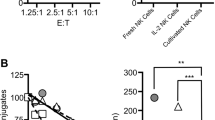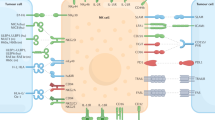Abstract
Human leukaemia cells isolated from peripheral blood were employed as targets for natural killer (NK) cells obtained from healthy donors and the effect of pretreatment of leukaemia cells with Actinomycin D on lysability was analysed in a chromium release assay. In 8/14 leukaemia cell samples a substantial enhancement of specific release could be repeatedly obtained by exposure of leukaemia targets to Actinomycin D for 4 h. The phenomenon was seen both with interferon-treated and untreated NK cells and could be demonstrated with fresh, as well as, liquid nitrogen stored leukaemia cells. In contrast, lysis of two leukaemia cell lines could not be further enhanced and no release was seen from normal lymphocyte targets or mitogen-induced blasts. Cold target inhibition studies indicate that enhanced killing is mediated by the same kind of natural killer cell, which is active against the Molt4 and K562 leukaemia cell lines.
This is a preview of subscription content, access via your institution
Access options
Subscribe to this journal
Receive 24 print issues and online access
$259.00 per year
only $10.79 per issue
Buy this article
- Purchase on Springer Link
- Instant access to full article PDF
Prices may be subject to local taxes which are calculated during checkout
Similar content being viewed by others
Rights and permissions
About this article
Cite this article
Ziegler-Heitbrock, H., Erhardt, J. & Riethmüller, G. Treatment of fresh human leukaemia cells with actinomycin D enhances their lysability by natural killer cells. Br J Cancer 48, 507–514 (1983). https://doi.org/10.1038/bjc.1983.223
Issue Date:
DOI: https://doi.org/10.1038/bjc.1983.223



